Episode #373: How We Boosted Math Scores in High School Without Homework or High-Stakes Tests
LISTEN NOW HERE…
WATCH NOW…
What happens when two math teachers throw out homework, redefine grading and assessment, and make student growth the heart of every math lesson?
Too many classrooms are dominated by points, pressure, and compliance. But what if your students actually chased learning—without sacrificing test scores or accountability? In this episode, Keenan Clark and Jake Towers join Jon Orr to reveal how they transformed their math classrooms by replacing traditional grading and homework with a feedback-rich, skills-based assessment system. The result? More engagement, better relationships, and soaring standardized test results.
Listen in to discover:
- How eliminating homework and embracing flexible assessment led to deeper learning and less stress
- The assessment shift that helped raise AP Calculus pass rates from 41% to over 80%
- Why building student-teacher relationships through weekly feedback conversations became the secret to sustained motivation
If you’re ready to ditch the points race and start fueling real learning, hit play now.
Attention District Math Leaders:
Visit Keenan and Jake’s website: skillsbasedclassroom.com
Not sure what matters most when designing math improvement plans? Take this assessment and get a free customized report: https://makemathmoments.com/grow/
Ready to design your math improvement plan with guidance, support and using structure? Learn how to follow our 4 stage process. https://growyourmathprogram.com
Looking to supplement your curriculum with problem based lessons and units? Make Math Moments Problem Based Lessons & Units
Be Our Next Podcast Guest!
Join as an Interview Guest or on a Mentoring Moment Call
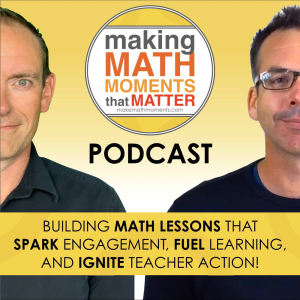
Apply to be a Featured Interview Guest
Book a Mentoring Moment Coaching Call
Are You an Official Math Moment Maker?
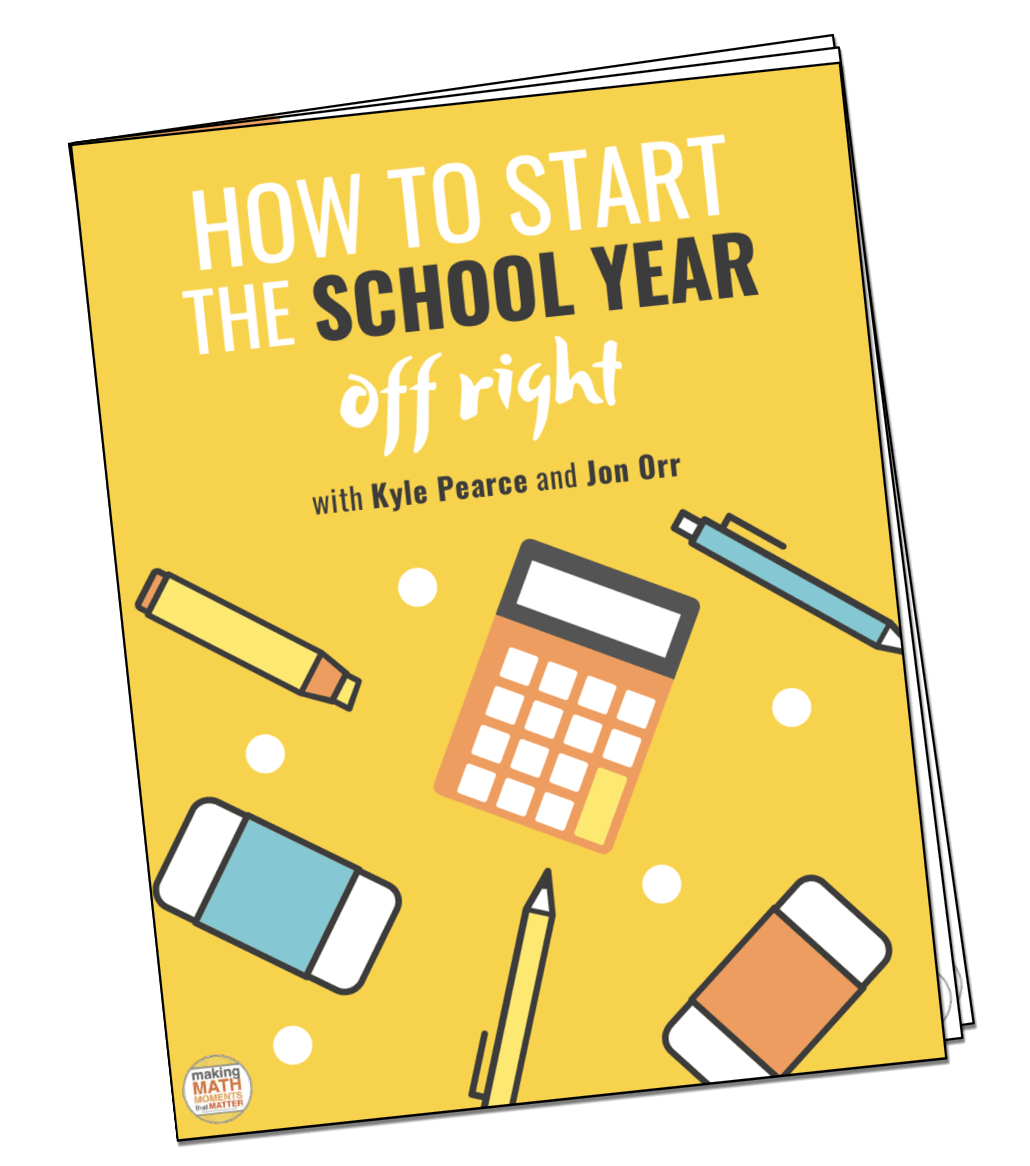
FULL TRANSCRIPT
Jon Orr:
Hey there Keenan and Jake. Welcome to the Making Math Moments That Matter podcast. We are excited to dig in. I know that we’ve had this on the calendar. We moved the date a couple times and we were eager to hear your story. And you know, when you reached out to us to talk about, your influence that you’ve had in the classroom and where that influence came from as a story, we thought this is a great story to share with the Making Math Moments That Matter community. So let’s get into it guys. Keenan, Jake.
Jake, let’s start with you. Where are coming from? What’s your teaching role? Give us a little snapshot of Jake Towers.
Jake Towers:
Yeah, so I’m Jake Towers and I’m from Carterville, Illinois. I’ve been teaching here for seven years. Before that, I student taught actually for Keenan. So it really worked out. Yeah, I’ve been with them a while and I’m teaching algebra one, which is our freshman level math course at Carterville High School and algebra two, which is primarily juniors at Carterville High School.
Jon Orr:
Great.
Jon Orr:
Got it, got it, thanks. Keenan.
Keenan Clark:
Yeah, I’m in year 27. Again, I’m Kenan Clark. I teach next door to Jake. He did his practicum for me. Actually, coincidentally, his dad was my high school baseball coach a long time ago.
Jon Orr:
Man, you guys got this connection happening, it’s cyclical, it’s a cyclical connection.
Jake Towers:
Mm-hmm meant to be meant to be
Keenan Clark:
So I taught for five years at Carterville Junior High. I was the eighth grade math teacher, taught some basic algebra and some eighth grade math, moved to the high school. And since then I’ve been teaching everything from geometry through calculus. think I’ve had calculus now for 20 some odd years. I did actually take a little bypass out of teaching. I went into administration for two years. I was an assistant principal at a four, five, six building. I had a great experience, really, really liked it. But what it did is it kind of reignited my passion for teaching.
Keenan Clark:
I saw some great things in the classroom and thought I could do things a little bit different. you know, when you look at teaching from the distance that I was at as an administrator, then you really feel like you can make some positive changes if you ever had a chance to do it again. Just so happened my old position opened back up, same classroom, same classes. And here I am back in Cardiff High School teaching Algebra II and AP Calculus.
Jon Orr:
Got it, got it. Yeah, that’s, we’ll dig, well, I think we’ll dig into that, you know, that journey a little bit, a little bit down the road here. But I do want, you know, to give you guys a chance to talk about your math moments, this moment that has influenced you about math education, your math class. Like we all get this image of math class when we say, when we say math class, it’s like, it’s just like burned into your brain that what this could be or what this is, and it usually has some sort of impact that sticks with you, you know, all these years.
Keenan, what would you say is like your math moment? So when I say math class, like what is popping into your mind as this kind of stick with you all these years moment?
Keenan Clark:
feel like my math journey began in a positive direction when I was in junior high. Our high school math teacher, had a math team at the high school. They were very successful. My brothers were math people at school. the high school math teacher came down and would always spend his prep period teaching eighth grade math to some of the advanced students. And I just, was lucky enough to be enrolled in that. And it was a fantastic experience. Very charismatic teacher, loved the kids, loved teaching, loved…
challenging us in a lot of different ways and so it just kind of ignited a passion for math for me. I had his classes for the next four years, his name’s Ron Nagradsky. He retired from teaching and then ended up going into working at the university level. He mentored Jake when Jake was at the university so there was another connection there that we had. that was it. When I was in junior high I had a fantastic teacher. I got to work with him.
Jon Orr:
Hmm. Great.
Keenan Clark:
and he still comes in and he does some guest lecturing for my classes from time to time. I let him come in talk to my Cal classes every year. So I want my students to have that same experience that I had to get to see and listen to this fantastic, charismatic teacher.
Jon Orr:
Was it the charisma that you kind of like grasp to and then is that what you’re trying to do in your classes now? Is that like that transition moment? Like oftentimes our math moments influence us either positive or negatively, which then have a, because that’s such an impactful moment for us, completely influences us what we do in our classrooms. So is that like, is it the charisma that you’re now transferring because that was an impactful moment or is it something else about what?
Keenan Clark:
I feel like a lot of it was the personality, the relationships, just being able to build the relationships. Everybody liked him, he was funny, he talked to us like we were human beings and not like we were robots that he was trying to train. It was a very conversational way for him to teach and I felt like that was positive for me, that’s what I needed. I feel like my students feel that way and so I try to channel that through my teaching from time to time.
the details of instruction and some of the science mechanics of it but if you don’t have a strong relationship with your students you’re not going to be very successful.
Jon Orr:
Yeah, yeah. I, you know, like something that kind of sticks out to me is, you know, I read, we read the book, Power of Moments a number of years ago. And part of the power of moments, we talked about this in one of our podcasts and sometimes, or one of our podcasts, but also one of our webinars. We’ve talked about it some of our live sessions, is the power, like some moments stick with us longer than others because what happens is someone or something here broke the script of like, what is traditional? Like, what is the normal?
And I’m curious, just to dig a little bit further here is like the relationships that were built with those teachers, did that feel like it broke the script and that’s why it had that impact on you? And like all the other math teachers you had weren’t that influence because it wasn’t the same type of relationship? Like I’m curious about like that, what was sticking out to you as maybe different and that’s why it stuck with you all these years.
Keenan Clark:
I mean it may seem trivial but I remember walking into class one day and we had an exam in class and one of the questions on the exam was a story problem and it was a I don’t specifically remember the details of it but my name was in the story problem so at some point in time he had integrated me and one of my friends and we were in some sort sort of caper and trying to get out of it and the the problem was revolving around us but it was not uncommon for that to be the case that…
Jon Orr:
Hahaha.
Keenan Clark:
He would integrate problems in class that involved the students and involved us personally and you just felt like you wanted to perform well, perform better for someone who had that kind of interest in knowing who you were and integrating you into the class.
Jon Orr:
Right, and that must have been different than the rest of the experiences you’ve had. Right?
Keenan Clark:
Yes, absolutely. you know, in the past everything was so curriculum based and here’s the next page of the book and here’s the next… We never even had a textbook. Like in his class it was you come in and we’re going to talk about what we need to know next. And it was… it didn’t feel so regimented as some of the math or other classes that I would have had in the past.
Jon Orr:
Yeah, yeah. And it goes to like, obviously, this is a testament to how we have impact on people based off what we’re doing in our classrooms. And things stick with people long after we think that that impact is there. And it matters. And it matters when we’re not making those connections with our students, because you fade away. You’re not part of Kenan’s memory right now. Those teachers who weren’t.
you know, who weren’t engaging as this individual. Maybe they were for other reasons, but not specifically for math class. Jake, math moment, you’re up.
Jake Towers:
Yeah, my math moment, I had great math teachers growing up, but my freshman year I met Forrest Morland, who was a math teacher at my high school for years. I was actually part of his last three years of teaching before he retired. And he just made, we worked bell to bell, but he was so laid back. He was goofy. He made everything fun. made, everyone in the room was having a great time when they walked in his door. And it might’ve been the best part of their day. And he just made us all feel like we were able to do the math.
Jon Orr:
Awesome. Awesome. Yeah. Again, just, just, it just, grew up those, those relationships, you know, completely matter and have, you know, I think a lot of us, you know, some, you know, my math moment, I don’t, was not about an individual. It was just about an experience. But I think, you know, when I, we ask people about those math moments, they’re all, most of them are tied to individuals. And we’ve got that, you know, going on here. Jake, how does, how does that influence what you’re doing in the classroom now?
Jake Towers:
He was able to build relationships with every student in the room and I think I try to carry that on. Try to make sure every student is seen, try to make sure every student knows that I care about their growth, not just in my math class but overall and just trying to make math fun. Try to make fun, have a great time and try to make the class the best part of their day.
Jon Orr:
Got it. Awesome. Yeah, that was one of my goals as well for kids that walked into my math class because I spent a good chunk of my career, like I guess half my day was usually working with students who were told they were bad at math or hated math. The other half was doing what you said, Keenan, is teaching calculus, teaching what we called it advanced functions, which is pre-calculus here. That was the other half of my day. splitting my time between those two vastly different kind of groups.
You know, allowed me to kind of open up what really matters in math class. Guys, let’s unpack some story here because you, in your messaging to us, you’ve had some significant success in what you’re doing in your classrooms. I’ll let you guys kind of pick on who wants to kind of talk about that success. Let’s talk about the current success and then let’s reverse engineer it. Let’s unpack where this journey came from and then where it, how it got to where we are now.
So let’s talk, give me one, give me two successes you feel like are moving the needle or you’ve got a needle that has moved and you wanna talk about it, but I’ll let you guys decide on who wants to start with a current huge success that you’re having in your classrooms.
Keenan Clark:
Okay.
Keenan Clark:
So when we revamped what we were doing in our classroom, we did a lot of it for ourselves. It would make us feel like we were having a better impact with doing that. And I know that our relationships with the students have improved greatly. But a lot of times, whether we agree with it or not, success is marked by how well you’re performing on your standardized tests and how well you have compared to other schools. And over the last…
Keenan Clark:
three years, our scores have, as far as our SAT scores, which is our standard test at the high school, it’s about to change, but our scores have been above the state average at Cardiff High School for a long time. And now our, that gap is growing. Like we’re really, we’re exceeding the state by more and more every year it seems. We feel like that’s in part a byproduct of us, obviously a big part of it is the students and the students work ethic and then buying into what’s going on at our school.
Jon Orr:
Hmm.
Keenan Clark:
our AP scores in my AP Cop class. Before I implemented our new system in the AP class, I think we had maybe 41 % of our students scored a three or higher that year, which I did not feel like was an acceptable level. I felt like I had failed them. And so we implemented this into the advanced students as well. Like our AP Cop students, that’s the highest level of math. That’s our capstone class at our district.
Last year was my first year of implementing it and I think we had 82, 81, 82 % of our students scored a three year higher. Like our scores were really, really good. And for a school our size to have 20, over 20 students pass the AP Calc exam and we only have 600 students in our school, that’s a really big accomplishment for us. So those are some of the tangible things that we see, but you know, as far as the relationships with the kids and how it’s growing with the parents, I can let perhaps Jake speak to that. Like he’s had some…
great experiences. If you’re less than 10 years of teaching and we’re having no parent issues and no administrative issues and students are happy with what’s going on, that speaks a lot too. So he could probably add into a little bit more on how that worked out in the classroom.
Jake Towers:
Yeah, so we made this change three years ago and we’re kind of known as the no homework guys in our high school. We don’t give math homework and the students and parents, the students really like that. The parents don’t believe them when they go home and tell them. But we’ve really changed the way we assess students and we like to give a lot of retake opportunities for any chapter. We call them our chapter skills now, but we let…
Jon Orr:
Hmm.
Jake Towers:
For example, chapter one’s in August, that’s when we start it. You can improve that grade retaking assessments up until the week before the final exam. So parents have really liked that opportunity for their children to be able to learn at their pace and then be able to retake assessments after getting feedback from us or talking to us one-on-one or just working at home if they want. And the students just see like the stress has gone away in our classroom. There’s, you know,…
We’ve shortened our assessments to four questions and they know that when they take an assessment, might not have their best day, but they’re able to show growth and retake it and show us and prove to us they’ve mastered certain skills.
Jon Orr:
You know, like, and I think when someone hears that too, it’s like no homework or change our assessment to allow retesting. Somebody might even argue to say like, okay, well, if you’re adding, if you’re allowing retesting, you’re not doing homework, and the kids are getting good grades in class, how does that transfer? But obviously, standardized test results have changed. So there is something that’s comparable across, because I think a big argument…
Other schools, other districts, probably other teachers have is like, yeah, but you’re probably assessing too easy or yeah, but you know, like, like those aren’t my kids, you know? And so, so there’s something that’s transferring there. What, what do you believe is the major difference that’s happened because of some of the shifts in probably classroom structure you’ve had, but also it sounds like assessment assessment has been a major shift for the work that the two of you are doing done.
Keenan Clark:
The biggest shift that I have noticed is that we have taken away this race for points to get a better grade in class. We’ve taken that aspect out, we’ve removed the compliance from basically all of what we do, and now the kids are kind of racing to the learning. When we shift the focus back on the learning, that made all the difference in the world. So the grades are going up and the scores are going up because the kids are holding themselves more accountable for their own learning in class.
And that sounds like, well, like you said, my kids won’t do that. Or that’s just a few kids at a certain school that’s always performed pretty well anyway. But we have a neighboring district that we’ve been working with for about a year and a half, two years now. they had low scores. They were probably getting close to being on academic probation. They were getting about 5 % of their students that were meeting or exceeding state standards, which obviously that’s around one out of every 20 students. two years inside of our system, like they completely adopted it. They are now at about 17%. Is that right, Jake?
Jake Towers:
Yeah, like 15 to 17, like maybe, yeah, in between there.
Keenan Clark:
They’re around 16 percent, so now it’s one out of every six students are meeting exceeding expectations there. So it is working at different districts, not just ours, but really the focus has been on learning. It’s really interesting in class whenever we hand out some work for some problems for them to work on and instead of them going to the easy ones and trying to complete it, they go to the hard ones. And we preach that over and over and over in class. Don’t go to the ones you already know how to do. You’re going to score well on those.
Go to the ones you don’t know how to do because the only way for your grades to improve is going to be build some more learning, build some more knowledge, increase your skills in these particular areas. And I see that every day that the students are no longer asking, is this due? When is it? What is this worth? Like the learning is going to come out the next time we assess you. It’ll probably be within the next day or two. So we really have to build something up and it’s not just a matter of completing tasks. Even when they go to their support.
They’re going to their tutors, their study halls, their small groups. They’re getting help there, not just on, well, we have to these homework assignments completed so we can get some more points and get that grade up. That no longer exists for us. Now when they go to their help and support, the support is like, all right, what skills are you lacking? And we can pinpoint almost exactly what they’re lacking in and they can work on those skills. That’s been the biggest change that I’ve seen is the mindset of the students just focusing on, I’ve got to learn this so that I can increase my grade.
Jon Orr:
Yeah, yeah, it sounds very much like that. Like you’ve shifted mindsets to go away from marketing to true learning. Now, what do you believe is then the real motivation right now? Because I think most teachers, especially high school teachers will say like, they’re not gonna do it unless it’s for marks. and I remember, you know, when I first started teaching thinking that way too, because the shifts I made sound very similar to the shifts you’ve made. Like we’ve, you know, we used to call them a growth.
you know, assessment for growth structure, which is the way that we started shifting our assessment, very standards based grading, very outcome based assessment type of work that we have to make shifts in throughout the course of the year and then commit to it and stick to it to make those cultural changes in the classroom. So it sounds very similar to the work that Kyle and I were working with, is amazing to hear. You’re seeing similar results as we saw. What do you believe is the main motivator right now for kids to like, to do this?
Is it still marks? Is it still grades? Or is it something else?
Keenan Clark:
Yeah, grades are, that’s really one of the most important things that every child, even students who say they don’t want to, they’re not concerned about school or maybe it’s not their thing, they still, they don’t want to fail and have to do it again. So they’re still aiming for some sort of target. We try to push that target as high as possible. But if you’re going to hold grades as a form of currency, then the only way that they can cash that in is through learning. If you let the grades be cashed in by, well, I took my notes and I turned them in.
Jon Orr:
Got it.
Keenan Clark:
I did my homework and I turned it in. Then yeah, that’s what they’re going to do. They’ll do just enough to get by. But now we’ve switched to where they have to do just enough learning to where we feel like they have a basic understanding of the concept. And there’s no other way to manipulate that for the students. mean, Jake can tell you the stories that he was seeing whenever I was in administration, really started, that was during the two years that we had a lot of restrictions because of COVID. Jake was in the classroom and I think he could probably tell you a little bit about the,…the learning and the race for the points that he was seeing that kind of helped us shift away from that.
Jake Towers:
Yeah. So when Keenan left, he left me and went to administration. was teaching the same classes I’m teaching now, same curriculum, but I just found I would walk into my classroom after the Tardy bell rang and I just see kids copying homework. They were just copying. They knew they were getting a zero if they got caught or if they got a zero for not doing it. It was just a race to how many points did I get to get that C or get that B or to get that A.
I was hitting a burnout as a fourth year teacher of just like, you know, it doesn’t feel like we want to learn math. And this is something, you know, I grew up because of math teachers I had, I was inspired to like want to work hard and learn the material. when Tina gave me a call one day in the spring of that semester and said, Hey, you want to change something? I said, we got to, because if we can make a change, going to help the kids and it’s going to help us. And my last three years of teaching have been the best three years I’ve ever had. And I just see it getting better and better and better.
Jon Orr:
Awesome. Keenan Wood. Now let’s keep kind of rewinding here because what I’ve heard is we’ve had significant success in shifting the culture of assessment in our classrooms and you’ve given some small glimpses. Now we’re on a podcast that is not, the teacher’s gonna get this idea of like, I need an assessment shift to make this happen so that I can also maybe emulate this but there’s a lot of details in between. We probably won’t get to all those details or we probably won’t get to all those details today because it’s like.
Keenan Clark:
Right.
Jon Orr:
Many, this is something that we’ve said here many times when we look at end results, like we’re hearing about your cultural shift in your classrooms around assessment, but it was many, probably little changes along the way that got you to where you are now. And sometimes it’s hard for a teacher to go, I want that too. Okay, well, I just have to change from today to that. And it’s like one change instead of a thousand little changes.
that we make on our journey. So I’m just gonna kind of roll back a little bit because Jake said he felt like there was pebble in his shoe around this culture of like race to get points and kids weren’t learning. And it was like, that’s not the experience he wanted for his students. That’s not the experience he remembered when he was in class, because he had motivation to kind of do more learning. He wanted to provide that for his students. Now this was also around the same time you were an administrator. Keenan, talk to us about…the transition, like why go to administration and then why come back?
Keenan Clark:
So I went into administration. was getting like Jake was getting a little stale in the classroom. We often refer to our traditional teaching approach and I felt like that was just it wasn’t doing it for me as far as motivation. My passion was starting to leak away from that a little bit. I went into administration and honestly I had a great experience in administration. The people that I worked with were fantastic. There was a great faculty.
I was an assistant principal and the principal was great, very supportive. And it was one of those environments where everybody seemed to share. They’re a PLC, model PLC school, everybody shared, no one held anything back. there was obviously you can see a lot of differences going on in the classroom. You know, from teacher to teacher, even though they’re a PLC school, teachers still had the freedom to be who they are. And a couple of things kept standing out to me.
And I went to Jake with this and he was seeing some of same things. And we narrowed it down to pretty much four areas that we thought if we were to get back into the classroom, or if I were get back into the classroom, instead of, to go back to the pebble in the shoe analogy, instead of trying to get that pebble out of the shoe, Jake and I thought, well, we’ve just dumped the shoe upside down. Let’s pour everything out and let’s decide how we’re to rebuild this. And so the four things that we looked at was that number one, felt like grades were not reflecting students’ ability at times.
You’d have a kid who was really, really bright. I’d hear a teacher say, you know, he can pick up on things faster than anyone, but he’s not doing this, not doing that, not being compliant. He’s getting a D. I don’t know if he’s going to pass. He’s picking up on things and he’s learning the math. We felt like that should be a focus should be shifted towards that. The learning pace, you can see it. It’s really exaggerated at that four or five, six level. noticed a lot of students who they’re getting new material. Things are really starting to shift to more conceptual ideas.
And so it takes some kids longer. Again, we look back at our traditional form that Jake was still using and I had used for 17 years or 22 years. Well, the end of chapter one, here’s your chapter one test, whether you pass it or fail it, you know what we’re doing tomorrow? We’re going to chapter two. And that was never considered. Well, how can we continue to integrate chapter one and keep that going? So we thought we’d address the learning pace issue that I was seeing a lot. Some of the teachers offered up more work and assignments than others.
Keenan Clark:
And when you have students that are gone and missing for, especially during COVID and you’ve got this makeup work and, all these policies and school policies, well, it was this day or that day. And how much time do they have? They should have contacted me about this. It becomes a mountain of work that makeup work. You know, that was a stress for the teachers and students and no one really fully understands it, especially the parents have a hard time understanding what’s doing when. And then the last one is the homework. Like the kids just did not like homework teachers.
We’re struggling with the homework. Yeah, there are some benefits to homework when it’s done correctly and when it’s done as it’s intended, but we felt like the homework was another big issue. We’re really getting enough out of the amount of effort that we’ve been putting in. Like I like to say, it was the juice worth the squeeze. It’s not, in a lot of the cases. So we felt like those were four big items that we needed to address. And within those four items, we thought, well, let’s start with…
Let’s start with the homework. If we got rid of homework, what chess piece does that move? Well, now we have to find the time to get some independent practice in. End class. Okay, well that’s going to impact something else. Having to give reassessments and giving students more time to learn, that’s going to push our test and our chapter test and the finality of that, that’s got to push that off the board entirely. We’ve got to find another way to assess them so that they can have multiple attempts so that doesn’t overwhelm us.
You know, how are we going to get around a student had an unexcused absence or a tardy, so I’m supposed to dock his grade by 50 % as per the school policy. How are we going to get around that? So now basically Jake and I have every assignment is due at the end of the semester. There are days that you’re supposed to turn it in, but if there’s an assessment and it gets pushed back or you can’t be there, mean, our high school today has 75 kids in a fall music or in the spring musical. So are we supposed to, you know, how are we going to manage that?
as far as all of them coming in, some of them made it, some of them didn’t. So there was a lot of little chess pieces. got one thing would bump the next to the next and then it turned around. And to be honest, Jake and I didn’t fully understand the board when we started this in August of 2022. We thought we’d thought the game out really well, but there were a lot of pieces that he and I were still moving for the first year. Like we were building the tracks as we were going along, but we knew we were onto something because the kids liked it. The scores were really good.
We weren’t failing anybody anymore. We were the same curriculum, same questions, same everything. But the kids were picking up on it better and our lives were so much easier as teachers. There’s this huge burden off of us by eliminating these problems. That may have been a longer answer than what you were looking for.
Jon Orr:
Yeah. Hey, no, no, it’s a, it’s a great answer. Like, and I want to comment on it, but I also want to kind of like, like ask this question as well, which is like, you went to administration, you obviously learned, you know, a new skill set at, as an administrator from being a high school math teacher, like what, what did you bring with you? Like what helped you in then coming back to the classroom? Like what would it, what lessons, skills, ideas, you know, new thinking that actually…
gave you a better, positioned you better to teach math again at the high school level and make these shifts, really.
Keenan Clark:
Well, having taught for so long and had the mindset of this is the best way to teach this, this is the best way to teach that, and I developed some concrete ideas of how to teach. And then I go watch a fourth grade teacher who’s doing a fantastic lesson and the kids are leading it. And I’d never really done a student-led lesson. Their feedback at the grade school was a lot better than the feedback we were giving at the high school. And I talked to Jacob, I was like,…
you know, when a kid doesn’t do well on a homework assignment, like what feedback are we giving them? And Jake would say, well, it’ll say three out of five instead of a five out of five. But that’s not feedback. And so we thought, well, I’m seeing conversations happen at the grade school, the four, five, six, because those kids need that and those teachers, you know, lot of them were very progressive and they were well read and knew what they were doing. And that was a big pickup for me. The biggest thing that really…
caught my eye is the first year we had summer school and the kids were sitting in the summer school and they were eating breakfast on the very first day. One of our fourth grade teachers walks over and she looks at those kids in that that breakfast room. She said, you know, the demographic of the students in here is not reflective of the demographic of the students in our general classrooms. She said we are failing this certain group of students and it was the students who didn’t have the support at home is the students that didn’t have…
the opportunities that some of the other ones did. Like we were doing a great job with certain kids but not a great job with others. And so I told Jacob, like we have to find a way to reach the students that aren’t being reached because that gap is only going to grow if we don’t change something. In my first year back in the high school, I was given the Algebra 1 Plus class, is our Algebra 1 student. It’s our entry level students who struggle in math, who need a little bit extra support.
I was given that class for two hours a day and they absolutely, they soaked this up like a sponge. Hey, you’re not gonna give us homework, you’re not gonna give us these tests and if I don’t understand it, you’re gonna let me try it again. Like they consumed it and they bought into it and I have a lot of those students that now turn back around. I have them in Algebra 2 and they’re very successful. Like they were on a path of not being successful and we feel like that turned them into a little bit more successful students and several of them will tell you that math is their favorite subject now.
Jon Orr:
Right. Right.
Jon Orr:
Right, yeah. Yeah, no, no, great, great, great insight. And I think, you know, when you think about some of those shifts you made from administration to the classroom, I think when we have the time to kind of, you know, when we’re teaching, we’re at that like.
one foot view, like we’re in it, like we’re in the weeds every single day. And it’s like, when we do take a step back and reflect and look, and you got a chance to see what’s happening in other places, not just your class, because that’s the time we teach in silos. And we rarely get outside of our class on a regular basis. But when we have that opportunity to kind of go, hey, what is happening in other areas? What is happening on the strands? What is other happening in other subject areas and grade levels and schools and school districts? This is where we gather insight to see.
You know, where we can then make a plan of attack to come back, to, do some real, some real, you know, in a way, good damage, you know, some good work. And like, like the way that you’ve articulated the structure you wanted to change is like, we recognize the problem mostly because you saw other areas. It sounds like that wasn’t a problem. Like this was a problem for us, but I didn’t know it was a problem until I saw all this other stuff. And then all of sudden, now we can then go, these are the four things we want to address. Let’s develop a system.
Keenan Clark:
Yes.
Jon Orr:
to address them and then let’s put that into action and see if it works. And that systematized approach goes a long way. And I think that’s kind of like partly probably what you got to bring from the administration level with you is to go like, can actually like strategize around this because I now have some flexibility to think about it and then bring it back. I’m curious too, Jake, talk to us about this dynamic, the two of you.
You know, what’s, what is, what is happening here at the school level? Are you guys co-teaching? Are you sharing? Like I know that for most, when I talk to teachers, you know, across, across North America and we, and we, we unpack their journeys. Uh, we’ve been doing, we’ve been doing this podcast since 2018 and we’ve had a lot of opportunities to talk with teachers across North America and the world. And, and it’s something that I feel like is common is the network that we have around us.
you know, the supports that we have around us. when I think about the changes that people have made, it’s always with someone else. talk to us about like, what the two of you help each other with. Like, what is the work time look like to support each other? Because I know that if I’m listening right now and I wanna make changes in my classroom, or maybe I’m already making changes, but I wanna know what it looks like when I do it with someone else. Because a of times, we could be doing it alone.
as a lone wolf, but I also could be doing with someone, maybe I, me and that someone could be strengthening our own working relationship. obviously you guys have something working here. So unpack it for us. Like what’s, what’s working well here.
Jake Towers:
So, know, was, I’ve been, Keenan was my mentor when I was in college and my first few years of teaching before he left. So when he came back, we just started diving headfirst. We met for hours in the summer of 2022, trying to build, trying to lay some tracks, as he said, before we actually got started teaching. And we more so just team up with philosophical ideas and what we really wanted to do. And then…
The first few months, we actually switched to performance-based rating. We graded all of our assessments on a scale of one to four. And one minor thing we noticed right away is if we were trying to debate on a score, I’d run over to his room and say, hey, look at this assessment. What kind of score do you think for this kid? And he’d give me his thoughts, or he’d come over to my classroom. The performance-based rating, we did a lot of practice going back and forth, just getting ideas.
When it comes to teaching the same class, we teach Algebra 2, we use the same curriculum, same guided notes. We have a live Google doc with all of our assessments and we just keep building assessments off it. We’ll give these same assessments. We’ll give two different ones every time we assess our students and we’re just constantly working. It’s really like, you know, I call him Batman and me Robin. We’re just always, well, he’s He’s older.
Keenan Clark:
Yeah.
Jon Orr:
Wait, why aren’t you Batman?
Keenan Clark:
Yeah.
Jon Orr:
I got it, that makes sense, that makes sense.
Jake Towers:
I don’t want say by how much, but he’s older. We are constantly just trying to improve too. During passing periods when we have four minutes in between classes, we just talk about how’d that lesson go for you? This is what I saw. This is what my kids got really well. He’ll just walk into my door one morning and say, hey, I have an idea for today. I was like, awesome, let’s roll with it. We just want to keep growing as educators because everyone says lifelong learners and we’re trying to actually do that minute by minute.
hour by hour every day. Even if it’s a two minute conversation just walk in the coffee room, we’re just trying to grow and bounce ideas off each other or change our assessment question, anything.
Jon Orr:
Right, awesome. No, awesome, awesome stuff. I got one last question for each of you. Keenan, will start with you. When we think about change and we think about making significant change in our classrooms, oftentimes we need that support. So you’ve been leaning on Jake, Jake’s been leaning on you. I’m sure that’s been as beneficial to you as it has been beneficial to him. What else? Like what other support?
have you used or had on your journey to help you give you insight, next ideas or feedback on the work that you changed going from your very traditional classroom to a more robust classroom that allows for, say, assessment for growth.
Keenan Clark:
We have some great administrators in our district. had before we started this, we went to our administrators in our high school and they were on board. You do what you got to do. We trust you. We think you can do it. Go right ahead. The administrator I worked with at the intermediate school, he was a huge support and help force. Name’s Dr. Tom Webb and then Doug Owens is a great school principal where my kids were going to school and they actually implemented standards based grading. And that’s where…
I saw like some really good things happening for me and he became one of the experts in our area on implementing that. But Jake and I were really big on, well your podcast for one, we would share almost daily, like, have you seen this episode? Have you seen that episode? Let’s listen to this one. Even if it were just a one or two minute clips that you were dropping on Twitter, we would share that. Like that’s a really good idea. Let’s put that in the back pocket and try to get to that sometime. You know, my wife, I…
Bless her heart. My wife teaches, she’s the head of the social studies department in our school. And the number of times that she heard me come home and complain about, well, this has got to be fixed or we’ve got to do this differently, whatever else. And she was so supportive and would allow me to, you know, kind of express my thoughts at home. But you’ve got to talk these things out. You’ve got to have somebody who will listen to you and bounce ideas off of. And Jake and I work together in a way such that it’s not, yeah, you’re right. I’ll make you feel good about that. If he disagrees.
he’ll tell me he disagrees. And it goes back and forth. If he puts a question on an assessment and I don’t think that it’s what our kids need as far as trying to have an impact on the skill, I’ll tell him, I don’t think this is good assessment question. And we don’t have hurt feelings and that’s just part of it. You’ve got to be willing to surround yourself with people who aren’t necessarily going to be yes, yes, yes all the time. You need people who have new ideas, people who will share and people who are okay if you don’t agree with them.
Jon Orr:
Love it. Jake, sounds like it’s Batman and Batman, not Batman and Robin, you know? So, yeah, I feel like you’re right. Our podcast is in a way meant to give you insight and ideas and nuggets to kind of like take and run with. It sounds like that works for you. But you’re right. You need that next layer of support. Like, who is that going to be? Where am I going to receive that? Like, we can’t do this in isolation.
Jake Towers:
Well, thank you.
Keenan Clark:
I would agree with that.
Jon Orr:
and if we can, it’s better to be done, not in isolation. And I think you guys have, have a, sounds like an amazing relationship to keep that growing. Jake, thinking about one, you know, we said that there’s a thousand steps that, gets you to where you are. What is, what is that? What was that first pebble that you rolled over? Like what was, what’s one actionable item for the listener right now that goes like, I’m not, I want to have an assessment for growth type classroom.
like what you guys have described here as the outcome. What is that first pebble that we have to turn over? And what does it look like sound like? What did you do?
Jake Towers:
So the first pebble to turn out, think offering, like we talked about the retake opportunities, and the biggest, we always tell our students, we don’t offer retakes until we can offer you quality feedback. So we do something called Feedback Fridays, and it’s a great, it’s my favorite day of the week, not that it’s Friday, but we pass, we usually get two assessments every week, and we pass those back to the students.
Keenan Clark:
Okay.
Jake Towers:
and then we pass back a log sheet that just keeps an accurate record of all their assessment grades for that semester. And then we kind of do it a little differently. This is when our students do all their independent practice. So we’ll let them work by themselves and then they work in small groups. And while that’s happening, I like to bring every student up to my desk. They’ve looked at their assessment for a few minutes. So I’ll have a kid come up and we’ll just have a one-on-one conversation. I’ll talk about what questions they might’ve missed.
Keenan Clark:
Okay.
Jake Towers:
We’ll talk about what strategies they can use next time or, you know, I’ve had students who go, hey, this is where I was thinking on this question and I’ll raise their grade. I’m like, hey, that’s a great idea. I see that now. Boom. And then I’ll talk to the next kid and I might, you know, it might be 30 seconds. If a kid got a perfect that week, I might just say, hey, how’s the track meet going? Or, you know, how’s the spring musical going? Or I might be talking to a student for two minutes, but I’m able to talk to a hundred students in one day and just kind of build a one-on-one relationship. And it’s really,…
Keenan Clark:
Okay.
Jon Orr:
Mm-hmm.
Jake Towers:
become very powerful, kids and I build a great rapport and it’s turned into a fantastic way to end.
Keenan Clark:
Thank
Jon Orr:
Awesome. Gentlemen, it’s been a pleasure to unpack your story and changes you’ve made and successes you’ve had and…
Jon Orr:
If a listener right now is kind of leaning in going like, I’d like to dig in. I’d like to learn a little bit more at any place, anywhere they can go and catch you or learn more about what you’ve been up to.
Keenan Clark:
Yeah, we have a landing spot on a website. It’s called skills based classroom dot com. And all of our contact information is there anytime that Jake and I are going to do presentations or work with groups. We post that on there. So that’s we also have a little blog that goes along with that and it shares some of our thoughts and philosophy strategies that we’ve used in the classroom. So.
We check that out quite a bit, but if you go to skillsbasedclassroom.com, you can also find us on LinkedIn, and we do have a Skills Based Classroom Twitter account, or X account now.
Jon Orr:
Awesome, awesome. We’ll throw that in the show notes, guys. Guys, thanks so much and looking forward to staying in touch and having a discussion in the future around what happened after this and what was next for you folks. So thanks guys, take care.
Jake Towers:
Thank you.
Keenan Clark:
Thank you, thank you very much.
Thanks For Listening
- Book a Math Mentoring Moment
- Apply to be a Featured Interview Guest
- Leave a note in the comment section below.
- Share this show on Twitter, or Facebook.
To help out the show:
- Leave an honest review on iTunes. Your ratings and reviews really help and we read each one.
- Subscribe on iTunes, Google Play, and Spotify.
DOWNLOAD THE 3 ACT MATH TASK TIP SHEET SO THEY RUN WITHOUT A HITCH!
Download the 2-page printable 3 Act Math Tip Sheet to ensure that you have the best start to your journey using 3 Act math Tasks to spark curiosity and fuel sense making in your math classroom!
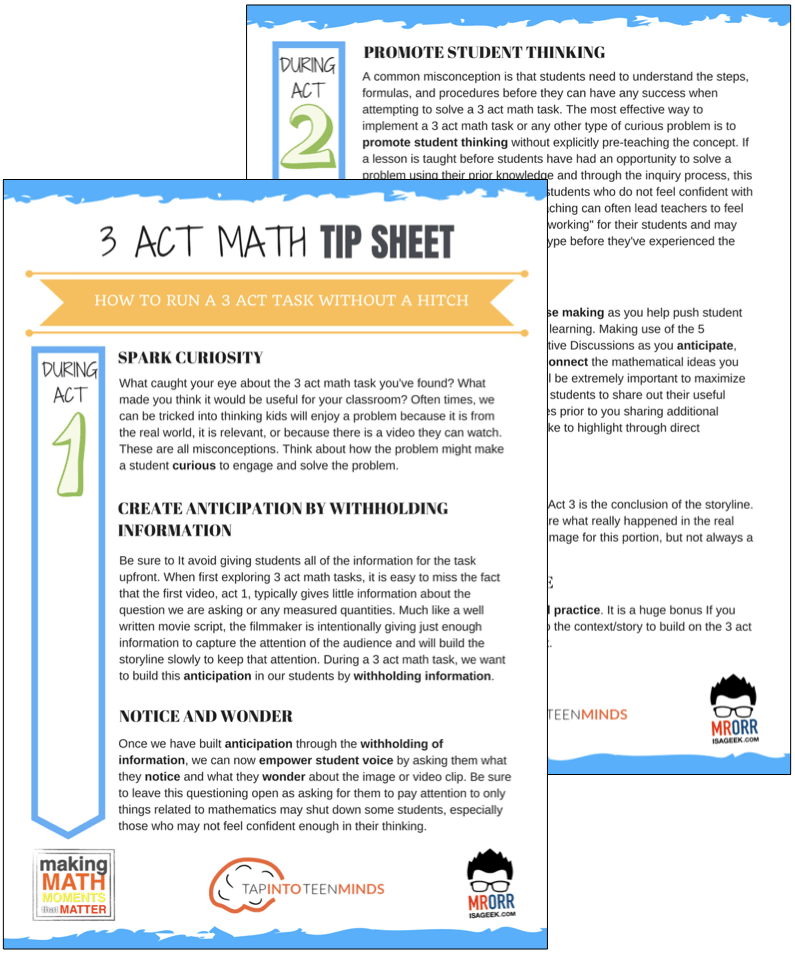
LESSONS TO MAKE MATH MOMENTS
Each lesson consists of:
Each Make Math Moments Problem Based Lesson consists of a Teacher Guide to lead you step-by-step through the planning process to ensure your lesson runs without a hitch!
Each Teacher Guide consists of:
- Intentionality of the lesson;
- A step-by-step walk through of each phase of the lesson;
- Visuals, animations, and videos unpacking big ideas, strategies, and models we intend to emerge during the lesson;
- Sample student approaches to assist in anticipating what your students might do;
- Resources and downloads including Keynote, Powerpoint, Media Files, and Teacher Guide printable PDF; and,
- Much more!
Each Make Math Moments Problem Based Lesson begins with a story, visual, video, or other method to Spark Curiosity through context.
Students will often Notice and Wonder before making an estimate to draw them in and invest in the problem.
After student voice has been heard and acknowledged, we will set students off on a Productive Struggle via a prompt related to the Spark context.
These prompts are given each lesson with the following conditions:
- No calculators are to be used; and,
- Students are to focus on how they can convince their math community that their solution is valid.
Students are left to engage in a productive struggle as the facilitator circulates to observe and engage in conversation as a means of assessing formatively.
The facilitator is instructed through the Teacher Guide on what specific strategies and models could be used to make connections and consolidate the learning from the lesson.
Often times, animations and walk through videos are provided in the Teacher Guide to assist with planning and delivering the consolidation.
A review image, video, or animation is provided as a conclusion to the task from the lesson.
While this might feel like a natural ending to the context students have been exploring, it is just the beginning as we look to leverage this context via extensions and additional lessons to dig deeper.
At the end of each lesson, consolidation prompts and/or extensions are crafted for students to purposefully practice and demonstrate their current understanding.
Facilitators are encouraged to collect these consolidation prompts as a means to engage in the assessment process and inform next moves for instruction.
In multi-day units of study, Math Talks are crafted to help build on the thinking from the previous day and build towards the next step in the developmental progression of the concept(s) we are exploring.
Each Math Talk is constructed as a string of related problems that build with intentionality to emerge specific big ideas, strategies, and mathematical models.
Make Math Moments Problem Based Lessons and Day 1 Teacher Guides are openly available for you to leverage and use with your students without becoming a Make Math Moments Academy Member.
Use our OPEN ACCESS multi-day problem based units!
Make Math Moments Problem Based Lessons and Day 1 Teacher Guides are openly available for you to leverage and use with your students without becoming a Make Math Moments Academy Member.
Partitive Division Resulting in a Fraction
Equivalence and Algebraic Substitution
Represent Categorical Data & Explore Mean
Downloadable resources including blackline masters, handouts, printable Tips Sheets, slide shows, and media files do require a Make Math Moments Academy Membership.
ONLINE WORKSHOP REGISTRATION
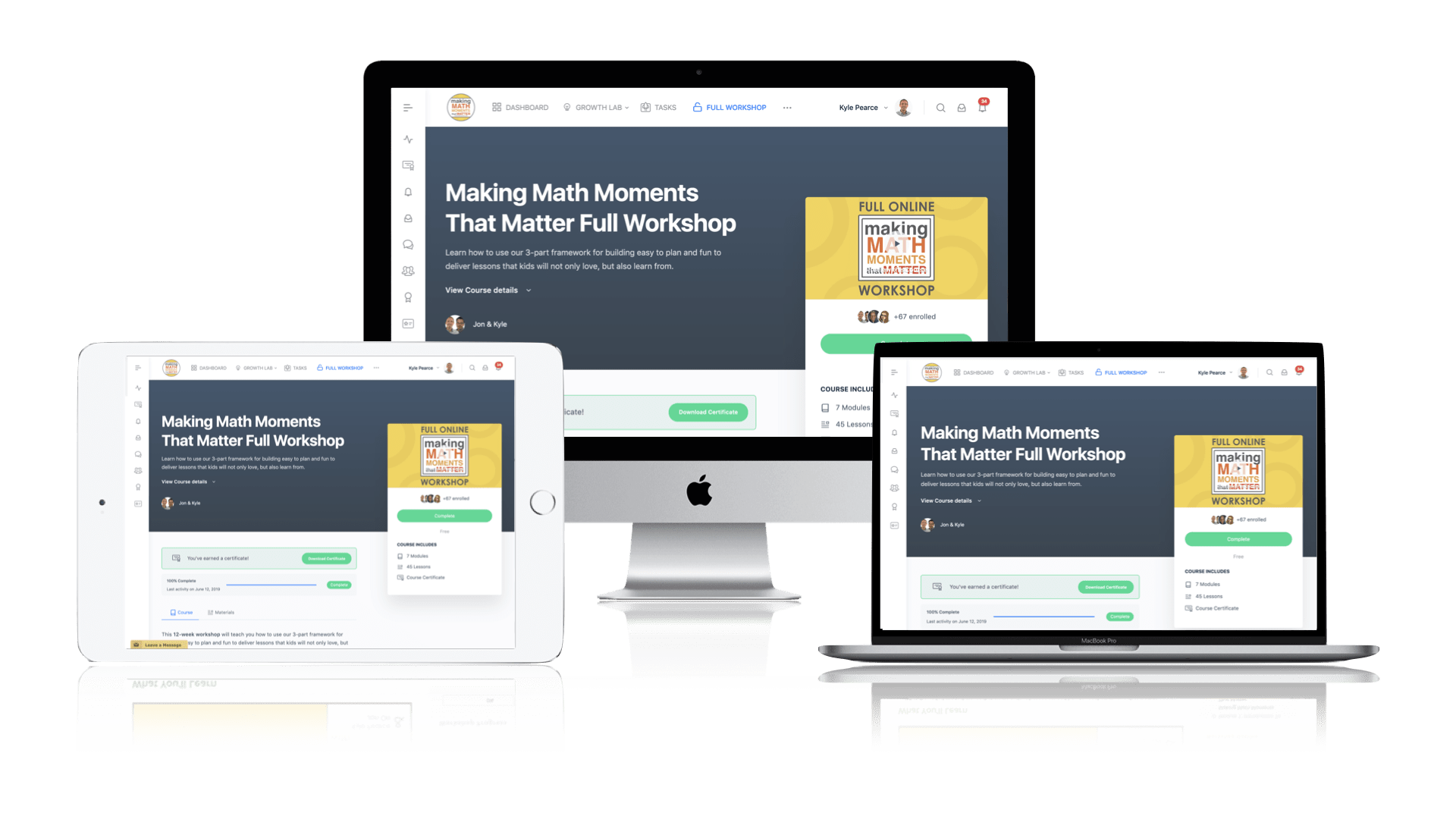
Pedagogically aligned for teachers of K through Grade 12 with content specific examples from Grades 3 through Grade 10.
In our self-paced, 12-week Online Workshop, you'll learn how to craft new and transform your current lessons to Spark Curiosity, Fuel Sense Making, and Ignite Your Teacher Moves to promote resilient problem solvers.
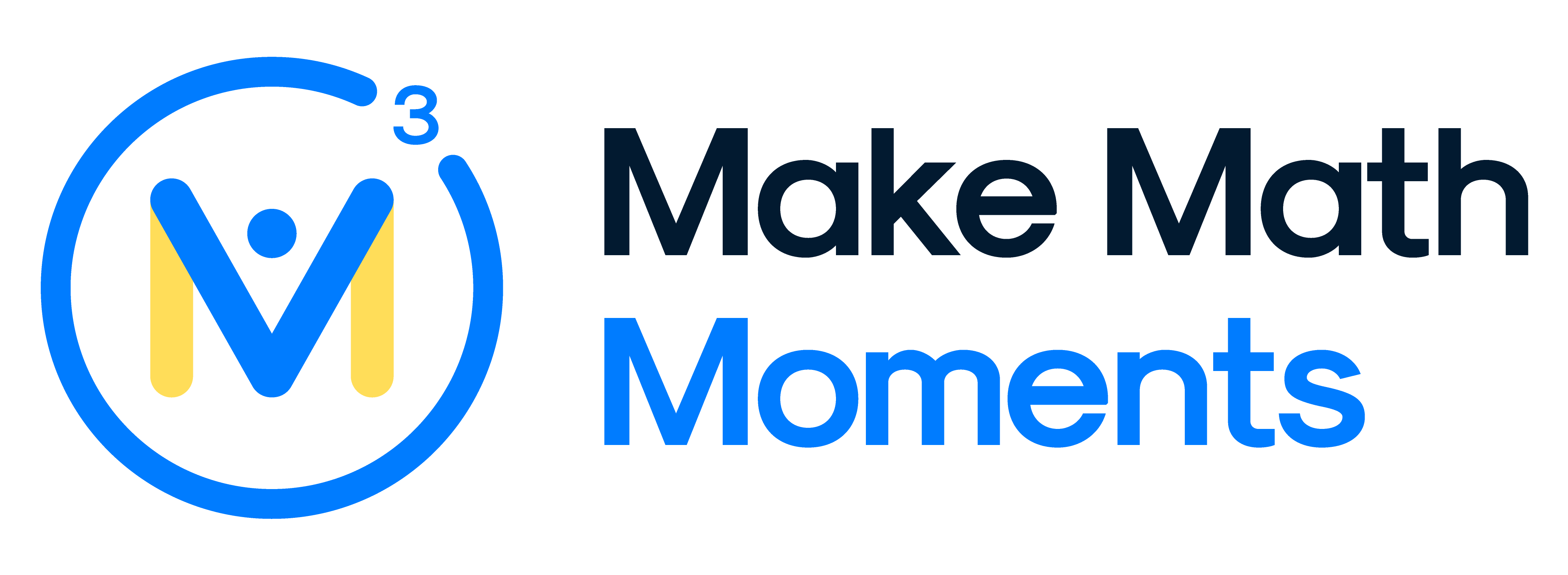



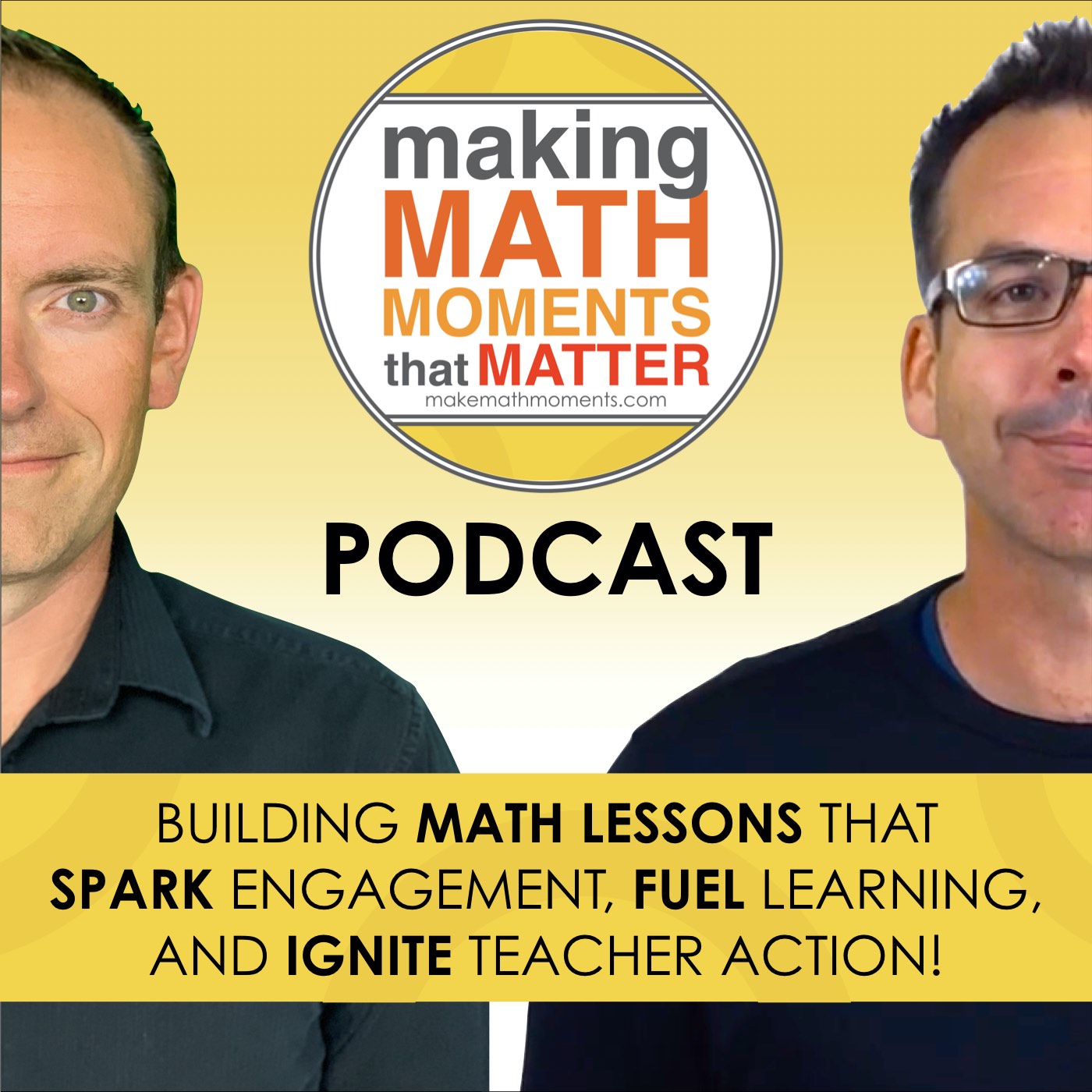
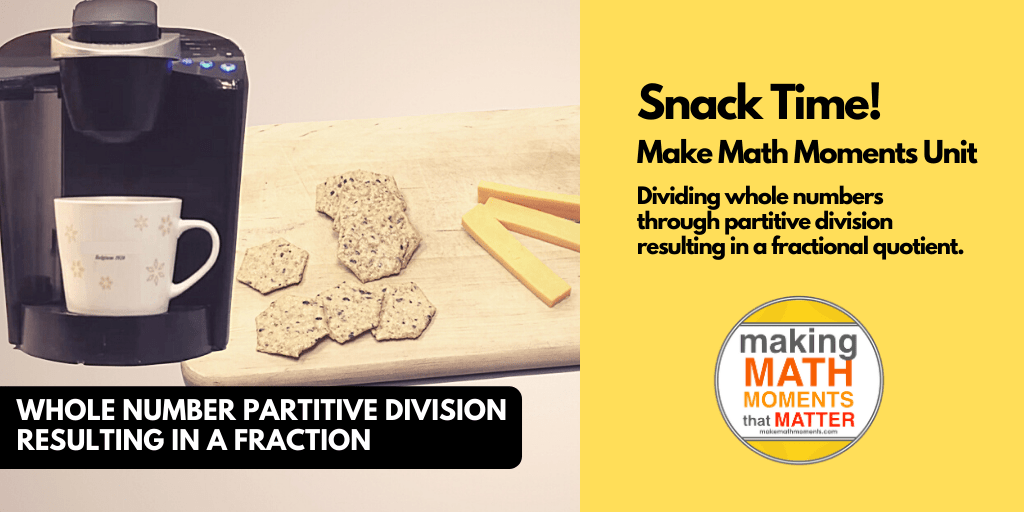

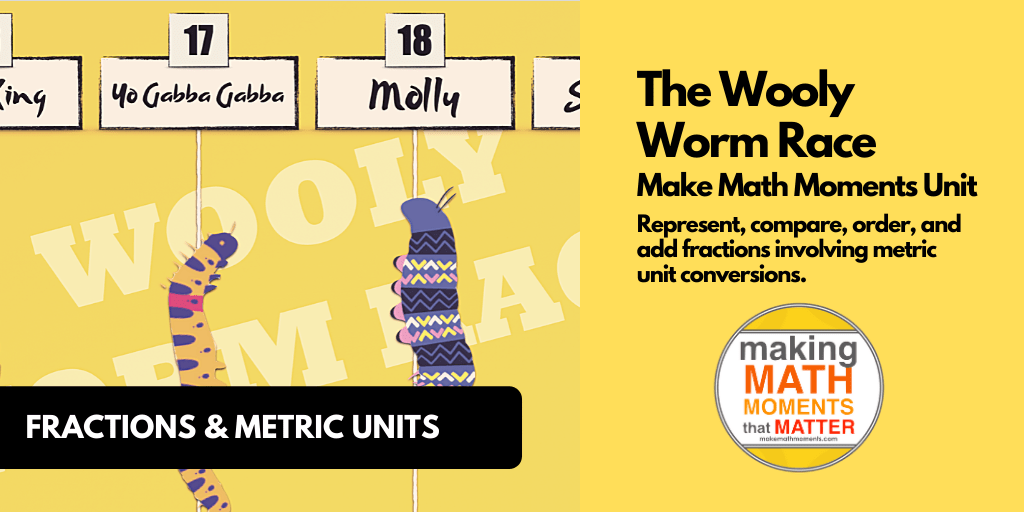
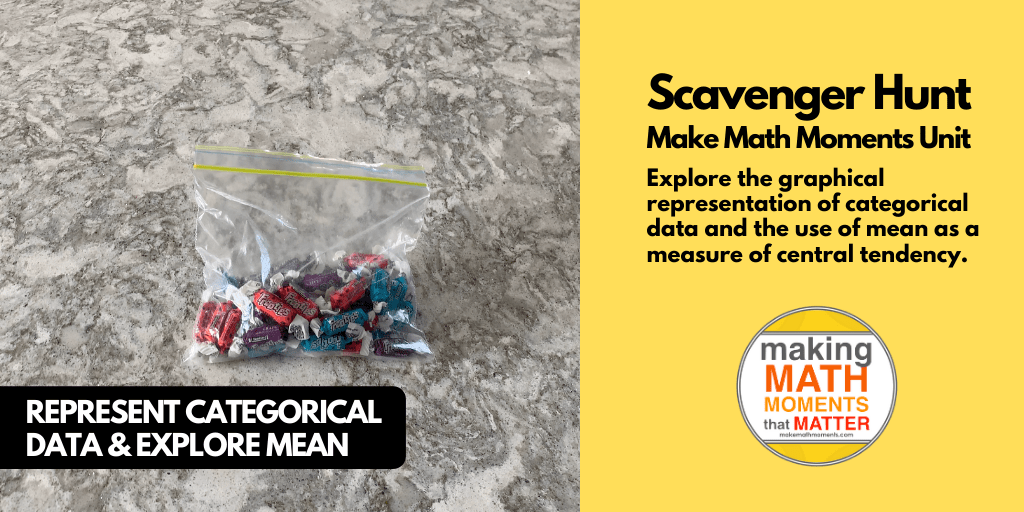

0 Comments